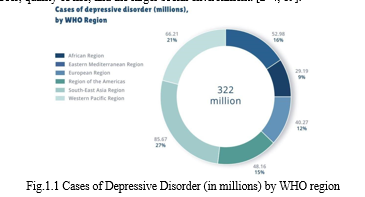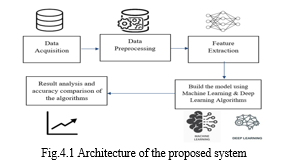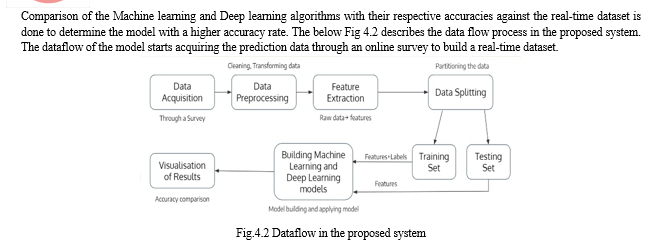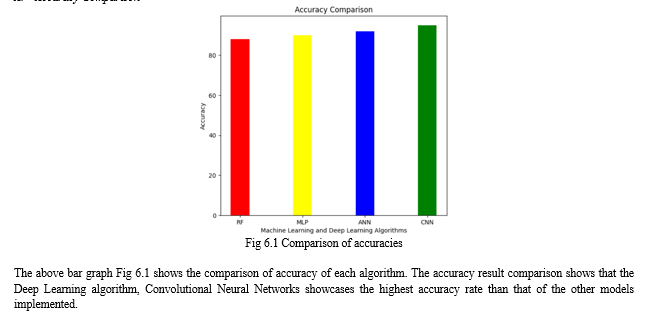Ijraset Journal For Research in Applied Science and Engineering Technology
- Home / Ijraset
- On This Page
- Abstract
- Introduction
- Conclusion
- References
- Copyright
Prediction of Mental Health Instability using Machine Learning and Deep Learning Algorithms
Authors: Ch. Radhika, N. Shraddha, P. Vaishnavi, K. Shirisha
DOI Link: https://doi.org/10.22214/ijraset.2023.54645
Certificate: View Certificate
Abstract
One’s mental health instability can hinder the individual’s life that leads to various health issues, like depression and anxiety that in turn results in mental imbalance or severe psychological instability. This psychological instability can lead to bipolar disorder. There are various reasons affecting one’s mental well-being, the reasons can either be modifiable or non-modifiable. Bipolar disorder causes changes in a person\'s mood and energy. People will experience intense emotional states because of disorder. Proper diagnosis and treatment is required for the people with this disorder which lead to healthy and active lives. Determination of this psychological instability can be predicted using machine learning and deep learning algorithms and the accuracies will be compared for the same. The dataset used is a survey based real time dataset which identifies the everyday activities and conditions of various individuals. The survey questionnaire consists of various questions determining the stress and psychological feelings among the individuals. This dataset is used in training the models to determine the prevalence of any psychological instability. Comparison of various bipolar classification methods with their performance accuracy against the real- time dataset is done. Detection of psychological instability plays a key role in reducing the risk of severity.
Introduction
I. INTRODUCTION
A wide variety of mental health conditions—disorders that impact your emotions, thinking, and behavior—are referred to as mental illnesses, sometimes known as mental health disorders. Depression, anxiety disorders, schizophrenia, eating disorders, and compulsive behaviors are a few examples of mental illnesses. Many people occasionally experience problems with their mental health. However, a mental health issue turns into a mental disease when persistent symptoms put you under a lot of stress and impair your capacity to perform daily tasks. Stress levels are rising as a result of modern lifestyles and ongoing work demands. As a result, many people experience mental disorders, which cause psychological issues. One of these, bipolar disorder, is one of the most incapacitating conditions, with alternating stages like manic and depressive moods rather than merely pleasant or terrible feelings. Mental health issues place a heavy burden on both individuals and society and have a considerable negative impact on many facets of life, including family, career, quality of life, and the larger social environment. [2–4, 19].

According to the World Health Organization (WHO), depression is the most common mental condition, affecting more than 300 million people globally. Because of the severity of the problem, many health researchers have chosen to concentrate their research in this area.
Fig.1.1 shows the statistics of cases of Depressive Disorder (in millions) by WHO region. Conditions, for example, stress and nervousness would all be able to influence mental health and disturb an individual's everyday life. According to epidemiological research, 13–20% of children and adolescents globally suffer from mental health issues. [6, 8–10]. The primary factor contributing to children and adolescents' health-related disabilities worldwide is mental health issues. [1] as in Fig.1.2 showing the Depression rates by age group from 2009 to 2017, according to the global health challenge of the twenty-first century [11]. The focus of research in recent decades has also been on the mental health and wellbeing of children and adolescents. [3–5, 20]. Examining the incidence rates of mental diseases around the world also reveals the scope of the issue.

From a clinical perspective, the main signs of depression [3] are forgetfulness, inability to concentrate, difficulty making decisions, loss of interest in hobbies and pastimes, overeating and weight gain, undereating and weight loss, guilt, helplessness, restlessness, and irritation, as well as suicidal thoughts. Taking care of mental health problems might help a person's outlook on life. By doing this, one can achieve harmony in their life [12]. Since it is difficult for machines to distinguish between anxiety, depression, and stress, an adequate learning algorithm is needed for a precise diagnosis.
II. LITERATURE SURVEY
Scientists have experimented with and researched a wide range of strategies for predicting psychological instability. The wrong approach to treating mental illnesses can have fatal consequences for the patient's mental health as well as irreversible negative effects. Millions of patients receive subpar care worldwide [13]. The analysis builds a semi-computerized framework that relies on the coordination of the hereditary calculation, arranging, information mining, and AI technologies. An integrated framework for displaying mental health co-occurrence on the web networks from these highlights is defined using an AI approach. They ultimately applied a precise, validated model to the slithered dataset. [14] According to this research, mental illness has grown to be a significant problem in society and has an impact on a person's ability to carry out their regular tasks. Stress and despair can lead to a variety of health issues. Solutions to the classification issue for bipolar disorder using multiple datasets and classification techniques are presented in contributions from diverse research writers. For the collecting and subsequent classification of data from blog posts, many academics have worked on predicting anxiety and depression using machine learning techniques, such as Random Forest Tree (RFT), the Support Vector Machine (SVM), and the Convolution Neural Network (CNN) [15]. The relationship between a person's physiological response and his emotional state is strong, and it can be utilized to differentiate between different emotions. Stress detection is the primary goal of the physiological measurements collected for this study [16]. There are numerous possible uses for identifying emotional states from physiological markers. Stress detection in human-machine interaction systems might give users a tool for keeping tabs on and possibly avoiding stress-related illnesses. Traditional machine learning methods have been employed in earlier research for automatic stress recognition, but they occasionally have particular drawbacks. [17] Deep learning's development makes it possible to see hidden patterns in bodily responses that would be difficult to see otherwise.
A. Finding Psychological Instability Using Machine Learning
The current system takes into account IT workers' stress levels. The dataset under consideration is a survey of working people that took into account all conceivable inquiries for stress detection. SVM, DT, and Random Forest are employed on the dataset for learning and detection in the designed technique, which uses the ML algorithm for stress identification. This approach finds the suitable algorithm for mental disorder prediction [18]. Many techniques that are used to identify mental disease in people of different ages.
In order to predict the degrees of decline among different age groups of working people, these systems employ a method of detection that involves analyzing the mental issue detection through a series of questionnaires. The current technique uses machine learning algorithms to identify mental disorders.
B. Disadvantages
Automatic stress recognition has been achieved using machine learning approaches, although these methods can have certain drawbacks [17]. The dataset used considers the stress detection among tech employees only. But stress is not restricted to the working class. Young adults also face various psychological issues. According to studies, worldwide, 13–20% of children and adolescents experience mental health issues [3, 6–8]. The dataset considered is a survey among the working people, which considered all possible questions related to their daily activities for stress detection [18]. But, knowing one's mental health condition also plays a critical role in psychological instability prediction. From a clinical perspective, the main signs of depression [3] include suicidal thoughts, weight gain, low appetite, loss of appetite, forgetfulness, inability to concentrate, inability to make decisions, feelings of guilt, worthlessness, helplessness, restlessness, and irritation. In case [15], it was discovered that these symptoms had a major impact on crucial facets of an individual's life.
III. PROPOSED SYSTEM
This system performs the stress detection among youngsters aged between 18 to 25 years. The dataset is a survey-based dataset, which considers all possible questions for detection of Bipolar disorder. Prediction of a possible psychological instability in young individuals, using Machine learning and Deep learning models based on a real-time psychological survey and to compare the accuracies for the same. The dataset considered all possible questions for stress detection among the individuals. Questions based on psychological feelings and emotions are considered in the survey. The approach finds the best suitable algorithm for Bipolar disorder.
As the existing system works only with dataset regarding one’s daily activities,
- The proposed system would have an efficient result as it considers an individual’s psychological feelings which play a key role in disorder detection.
- The existing system implements only Machine learning models, whereas the proposed system also works with Deep Learning models giving improved performance accuracy.
IV. METHODOLOGY
The process of building the disorder prediction system starts with collection of the data. The data for preparing the dataset has been collected through an online survey through a Google form. The forms were filled by individuals between the age group of 18 to 25 years of age. A real-time survey dataset was built using a self-assessment questionnaire. The questionnaire consists of various questions relating to one’s psychological, emotional state and mental well-being. The survey dataset was then used as the training data to train the prediction models. The following Machine learning- Random Forest Classifier and Multi-Layer Perceptron Classifier and the following deep learning Models-Artificial Neural Networks, Convolutional Neural Networks, were trained and tested against the real-time dataset. The performance of the trained models has been analyzed and compared. The accuracy rates of each model have been studied and the model with a higher performance has been deduced.
A. Architecture
The Fig 4.1 shows the system architecture which includes different stages like classification process and accuracy comparison of the models. The final result of the implementation would be the determination of the model with a higher accuracy rate.


The dataflow of the model starts acquiring the prediction data through an online survey to build a real-time dataset. The collected data is then undergoing preprocessing and the raw data is cleaned. Once the data is preprocessed the data is labelled taking according to the feature weights. Then comes the process of feature extraction where the unnecessary columns are removed and data is converted to features. The feature vectors are now split accordingly. The features are split into training and test datasets with a split ratio of 70:30 respectively. The training data is labeled input used to train the model for prediction. Whereas the test data is the unlabeled data used for the prediction process. The split data is used to build the models. The models are- Random Forest Classifier, Multi-Layer Perceptron Classifier and Artificial Neural Networks, Convolutional Neural Networks respectively have been trained and tested against the acquired dataset. The accuracy results of each model have been visualized and compared to determine the model with a higher performance and accuracy rate.
V. DATASET DESCRIPTION
The dataset considered is a real time survey-based dataset. The dataset consists of 1500+ labelled data items, used to train and test the models. An online survey is performed among individuals aged between 18 to 25 years, which considers all possible questions for stress detection. The survey questionnaire consists of various questions determining the stress and psychological feelings among the individuals. The dataset consists of 38 attributes with data as 0 or 1 for each of the attribute. The dataset contains the following attributes:
- Age.
- Gender.
- Do you feel self-confident?
- Do you really feel well inside?
- Do you feel depressed?
- Do you do unusual things at times?
- Do you feel full of energy?
- Do you have racing thoughts?
- Do you get distracted easily?
- Do you feel restless?
- Do you become talkative at times?
- Does your mood change a lot?
- Do you get easily irritated?
- Do you feel argumentative?
- Do you get agitated?
- Do you have enough concentration?
- Do you sleep well?
- Do you behave not like your usual self at times?
- Do you become hyper sometimes?
- Do you feel worthless at times?
- Do you find yourself guilty at times?
- Do you have self-doubt or low self-esteem?
- Do you feel pessimistic about everything?
- Do you feel sad or hopeless at times?
- Do you become delusional or have hallucinations?
- Do you lack appetite sometimes?
- Do you have thoughts of self-harm or have suicidal thoughts?
- Do you show excessive anger or aggression?
- Do you tend to forget things?
- Do you get tired of doing things easily?
- Do you feel emotionless at times?
- Do you become reckless and act out of control sometimes?
- Do you feel anxious sometimes?
- Do you constantly keep forgetting things?
- Do you have no interest or pleasure in doing things?
- Did you find any major change in your weight?
- Do you have a bad feeling about yourself or that you are a failure?
Each attribute of the dataset corresponds to a question in the survey. The choice of an option Yes or No to each individual question is considered as the value of 0 or 1 in the feature columns. The final attribute is classified into two categories i.e., Normal or in- stable, based on the responses given to the survey questionnaire.
VI. RESULT ANALYSIS
The algorithms have been implemented for the instability prediction and the results have been analyzed. The Machine learning algorithms, Random Forest Classifier, Multi-Layer Perceptron Classifier and the Deep learning algorithms, Artificial Neural Networks and Convolutional Neural Networks have been implemented for the classification process; and the results are as follows:
A. Accuracy Comparison


Conclusion
For the purpose of identifying mental illness in people of all ages, there are numerous approaches for detecting mental health disorders. These systems analyze the mental issue identification via questionnaires as their strategy for identifying psychological instability. A survey is undertaken to gather real-time data in order to predict the stress levels among people between the ages of 18 and 25. The study has taken into account the dataset with more than 1500 samples. Algorithms for machine learning are used to identify mental disorders. The dataset has been used to train and evaluate the machine learning models, Random Forest Classifier and Multi-Layer Perceptron Classifier, as well as the deep learning models, Artificial Neural Networks and Convolutional Neural Networks, for the detection of instability. The results of the experiment showed that the Multi-Layer Perceptron Classifier achieves an accuracy of 91% and the Random Forest Classifier of Machine Learning Models achieves an accuracy of 89%. Contrary to Deep Learning models, Artificial Neural Networks and Convolutional Neural Networks have accuracy levels of 93% and 95%, respectively. Comparison of their respective performance accuracies shows that the Deep learning model, Convolutional Neural Network demonstrates a higher accuracy of 95%. The instability detection system has a scope of expansion in the future to increase the system accuracy and performance levels. The dataset would be increased and enhanced to improve the efficiency of the system. In the future, the system can be expanded to by including face emotion recognition as well to enable further enhanced process of instability prediction through facial data. This would further enhance the classification system for instability prediction.
References
[1] Ghassan Azar, Clay S. Gloster, Naser EI-Bathy, Su Yu, Rajasree Himabindu Neela and Israa Alothman, Intelligent data mining and machine learning for mental health diagnosis using genetic algorithm. DOI:10.1109/EIT.2015.7293425, 2015 [2] Bastiaansen D, Koot HM, Ferdinand RF, Determinants of quality of life in children with psychiatric disorders. Qual Life Res 14:1599–612, DOI: 10.1007/s11136-004-7711-2, 2005 [3] Belfer, M.L. Child and Adolescent Mental Disorders: The Magnitude of the Problem across the Globe. Journal of Child Psychology and Psychiatry, 49, 226-236. http://dx.doi.org/10.1111/j.1469-7610.2007.01855.x, 2008 [4] Breslau J, Lane M, Sampson N and Kessler RC, Mental disorders and subsequent educational attainment in a US national sample. J Psychiatr Res 42(9):708–716, 2008. [5] B. Saha, T. Nguyen, D. Phung and S. Venkatesh, A Framework for Classifying Online Mental Health-Related Communities with an Interest in Depression, in IEEE Journal of Biomedical and Health Informatics, vol. 20, no. 4, pp. 1008- 1015, July, 2016. [6] Erskine, H E; Moffitt, T E; Copeland, W E; Costello, E J; Ferrari, A J; et al.?A heavy burden on young minds: the global burden of mental and substance use disorders in children and youth. Vol. 45, Iss. 7, (May 2015): 1551- 1563. [7] Houtrow A, Okumura MJ, Pediatric mental health problems and associated burden on families. Vulnerable Child Youth Stud 6(3):222–233, 2011. [8] Jonsson U et al, Annual research review: Quality of life and childhood mental and behavioural disorders - a critical review of the research. J Child Psychol Psychiatry 58(4):439–469, 2017. [9] Kieling C et al, Child and adolescent mental health worldwide: evidence for action. Lancet 378(9801):1515–1525, 2011. [10] Kovess-Masfety V et al, Comparing the prevalence of mental health problems in children 6–11 across Europe. Soc Psychiatry Psychiatr Epidemiol 51(8):1093–103, 2016 [11] R. Jadhav, V. Chellwani, S. Deshmukh and H. Sachdev, \"Mental Disorder Detection: Bipolar Disorder Scrutinization Using Machine Learning,\" 2019 9th International Conference on Cloud Computing, Data Science & Engineering (Confluence), Noida, India, 2019, pp. 304-308, doi: 10.1109/CONFLUENCE.2019.8776913. [12] Polanczyk GV et al, Annual research review: A meta-analysis of the worldwide prevalence of mental disorders in children and adolescents. J Child Psychol Psychiatry 56(3):345– 365, 2015. [13] Sabrine Dhaouadi, Mohamed Moncef Ben Khelifa, A Multimodal Physiological-Based Stress Recognition: Deep Learning Models’ Evaluation in Gamers’ Monitoring Application Impact de l\'Activité Physique sur la Santé Laboratory, IAPS 978- 1-7281-7513-3/20/$31.00 2020. [14] Sau, A., Bhakta, I, Predicting anxiety and depression in elderly patients using machine learning technology, Healthcare Technology Letters 4 (6), 2017. [15] Smith, Stacy L., Ken Lachlan, and Ron Tamborini, Popular video games: Quantifying the presentation of violence and its context, Journal of Broadcasting & Electronic Media 47.1: 58- 76, 2003. [16] Tyshchenko, Y, Depression and anxiety detection from blog posts data, Nature Precis. Sci., Inst. Comput. Sci., Univ. Tartu, Tartu, Estonia, 2018. [17] V. Uady Kumar, Alekhya Savithri, M. Jhansi Bhavani, A. Madhu Priya, Finding Psychological Instability Using Machine Learning, 22 September 2020, DOI: 10.1109/ICSSS49621.2020.9202009, 2020. [18] Wittchen HU et al, The size and burden of mental disorders and other disorders of the brain in Europe 2010, Eur Neuropsychopharmacol. 21(9):655–679, 2011. [19] https://www.who.int/publications/i/item/9789241514019. [20] https://adaa.org/understanding-anxiety/depression/symptoms.
Copyright
Copyright © 2023 Ch. Radhika, N. Shraddha, P. Vaishnavi, K. Shirisha. This is an open access article distributed under the Creative Commons Attribution License, which permits unrestricted use, distribution, and reproduction in any medium, provided the original work is properly cited.

Download Paper
Paper Id : IJRASET54645
Publish Date : 2023-07-06
ISSN : 2321-9653
Publisher Name : IJRASET
DOI Link : Click Here
 Submit Paper Online
Submit Paper Online

